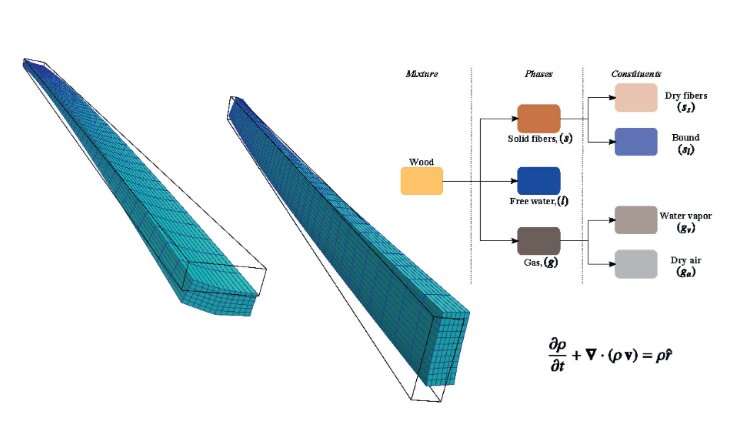Credit: DOI: 10.15626/LUD.485.2023
Wood is a naturally growing material that has been used as building material for centuries. However, its high moisture content makes it difficult to use as load-bearing structures without drying processes. In a new Ph.D. dissertation in building technology, Winston Mmari studies the interaction between heat, moisture, and transport mechanisms in wood and develops a model to predict the behavior of wood under mechanical load at different moisture and temperature conditions.
Wood has high initial moisture content and a chemical composition that makes it very sensitive to moisture. The moisture content of wood affects its physical and mechanical properties and requires drying processes for use in load-bearing structures. Describing moisture distribution and moisture transport in wood is challenging, as wood consists of different phases and processes such as absorption, evaporation/condensation, and swelling/shrinkage of wood fibers.
"The primary goal of the dissertation is to develop a model that can predict the macroscopic behavior of wood under mechanical load while also exposed to varying moisture and temperature conditions," says Mmari.
Wood exposed to moisture or mechanical loads
The dissertation studies the behavior of wood that is exposed to moist or subjected to mechanical loads. The properties of wood are described, and theoretical models are used to predict its behavior. The dissertation consists of four parts with models and simulations.
In the first part, it is described how moisture moves in wood. The model is then improved in the following parts to take into account also moisture levels and distortions of wood due to moisture changes. Simulations are also conducted to test the models. In the final part, the study focuses on how wood cracks, and a special model is used for this. Through simulations, the model's capabilities are examined, and the results are compared to experimental observations.
"The processes of moisture absorption and movement within wood go hand in hand with temperature changes in the material. My dissertation shows that these complicated moisture transport mechanisms in wood and the resulting distortions and cracks can be described with models built on strong mathematical theories and be predicted through computer simulations," Mmari continues.
Tools for analysis and prediction
The study can be useful both for the wood industry of today and for future research.
"The model that has been developed can be used as a tool for analysis and to predict the behavior of wood elements and structures. The models can be used to investigate and possibly optimize the drying processes for wood. In addition, the results from this study help direct researchers towards the right directions for future experimental and theoretical studies aimed at improving the knowledge and understanding of this environmentally friendly material," Mmari concludes.
More information: Winston Mmari, Multiphase continuum modeling of wood: A hybrid mixture theory approach (2023). DOI: 10.15626/LUD.485.2023
Provided by Linnaeus University
























